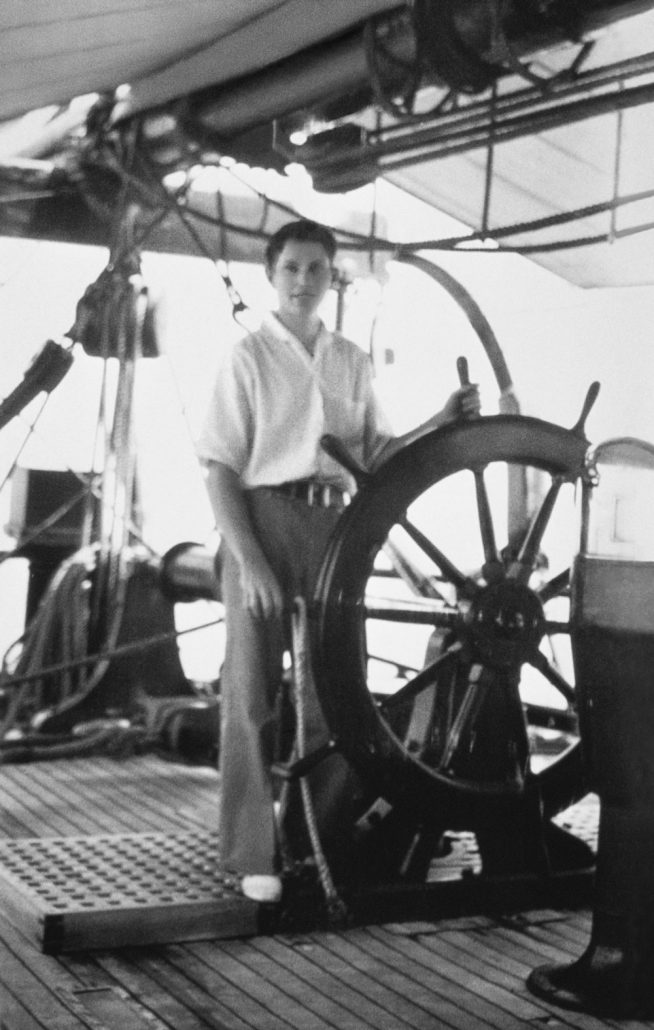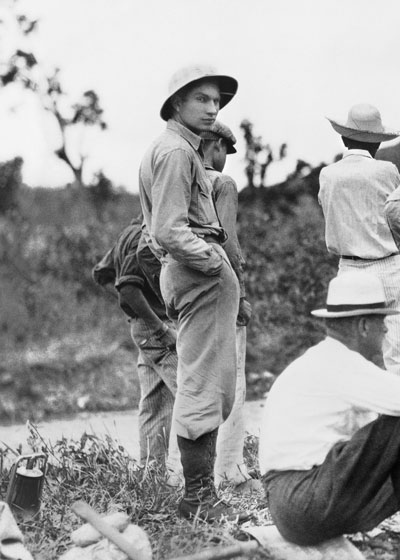1927
During early June, Ron travels to San Francisco and embarks on a voyage to Guam via Hawaii, Japan, China, Hong Kong, and the Philippines. In the first week of July, he meets his father in Guam. During these travels, he carefully records his adventures and observations. Articles about his journeys appear in the Helena High School Nugget and the Helena Independent.
By September, he is back in Helena and becomes an editor of the Helena High School Nugget. In October, he joins the Montana National Guard’s 163rd Infantry.
1928
In early May, as the school year is drawing to a close, he organizes and enters a group of classmates in Helena’s annual Vigilante Day Parade. They receive the “Most Original” award for his entry of Spanish Main pirates. This and other events are carefully recorded in a ledger along with short stories based on his travels. He will continue recording fragments of stories in that ledger for the next two years.
Ron leaves Helena again in May, and in July travels aboard the USS Henderson from San Diego to Guam. From there, during the next fourteen months, he journeys inland to the western hills of China, back to Japan, down to the Philippines, and south to Java. He befriends a British intelligence officer, Buddhist priests, a man who is last in a line of magicians descending from the court of Kublai Khan and meets people from many varied cultures and backgrounds. L. Ron Hubbard gains greater nautical expertise aboard the twin-masted coastal schooner Marianna Maru as he plies the waters off the China coast as a helmsman and supercargo. A selection of his photographs from these travels is purchased by the stock photograph house Underwood and Underwood and by National Geographic.
1929
Ron returns to the United States in September to complete his high-school education. He attends Swavely Prep School in Manassas, Virginia, where he writes a number of school papers, including “Should the Philippines Be Liberated?,” “Modernism,” “Go Thou Fair Lad and Discover Thy Imagination,” and a book report on Revolt in the Desert by T.E. Lawrence, more familiarly known as Lawrence of Arabia.
1930
In February, Ron enrolls at Woodward School for Boys in Washington, DC. In March, he writes and delivers a prize-winning speech on “The Constitution—A Guarantee of Liberty to the Individual” in a regional oratory contest.
He enlists in the 20th Marine Corps Reserve, Company G, during May, is appointed first sergeant in June, and turns out a prize-winning drill team.
Ron graduates from Woodward and in September enrolls at George Washington University (GWU). His studies include engineering courses and atomic and molecular phenomena, but here he also carries out his first investigation of the structure and function of the human mind. Earlier, during the summer, he launches a professional writing career, scripting dramas for radio station WJSV while attending classes at George Washington University. He also writes and performs ballads on local station WOL, all the while employed as a photojournalist/reporter by the Washington Herald.
1931
While Ron continues his studies at GWU, he takes up glider flying, becomes recognized as a daring pilot, and sets a national soaring record for sustained flight over the same field. He also becomes a powered-flight pilot and barnstorms across the Midwest in September with a friend. He is elected president of The George Washington University Flying Club, is secretary of the GWU chapter of the American Society of Civil Engineers, and joins a team of surveyors sent to verify the US-Canadian border in Maine.
1932
In January, L. Ron Hubbard sells his first magazine article, “Tailwind Willies,” to the aviation journal Sportsman Pilot. In it, he details the latest aviation developments and advises pilots on flight procedures in adverse conditions.
As an editor and writer for the University Hatchet at GWU, Ron produces his first published fiction story, “Tah,” in February, and a short adventure story, “Grounded,” in April. Both are peripherally based on personal experiences or the experiences of people he encountered in the Far East. In May, he wins the Literary Award at GWU for the best one-act play with “The God Smiles,” drawn from his travels in China.
In the spring, Ron organizes and leads the Caribbean Motion Picture Expedition. He is joined on the two-and-a-half-month, five-thousand-mile journey aboard the two-hundred-foot, four-masted schooner Doris Hamlin by more than fifty adventure-seeking college students. The voyage is completed by September. The crew brings numerous floral and reptile specimens back for the University of Michigan and Ron’s photographs are sold to the New York Times.
In October, he embarks upon a voyage to Puerto Rico. As part of the West Indies Mineralogical Expedition, he not only completes the first mineralogical survey of Puerto Rico as an American territory but writes articles for the Sportsman Pilot about flying through the Caribbean Islands. He also investigates and explores some of the area’s diverse cultures and beliefs, including voodoo and Espiritismo.
In November, his “Sans Power” appears in the Sportsman Pilot. His first nautical story, “Submarine,” appears in the University Hatchet the same month.
1933
The expedition to Puerto Rico is completed in April. In May, his article “Washington’s Langley Day” appears in the Sportsman Pilot.
Ron returns to the mainland and soon moves to a small California beachfront town north of San Diego. There, while continuing to do articles for the Sportsman Pilot, he also begins his professional career as a writer of fiction. With customary gusto, each day he writes a story ranging in length from 4,500 to 20,000 words and submits it to New York publishers in an attempt to crack the market. It takes him six weeks and then he sells two stories for three hundred dollars—a princely sum in days when hamburger costs ten cents a pound. By the end of the year, he is writing at a more relaxed pace—what will become his average 100,000 words a month.






